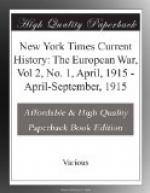I will refer first to the operations which are now in progress in the Dardanelles. [Cheers.] It is a good rule in war to concentrate your forces on the main theatre and not to dissipate them in disconnected and sporadic adventures, however promising they may appear to be. That consideration, I need hardly say, has not been lost sight of in the councils of the Allies. There has been and there will be no denudation or impairment of the forces which are at work in Flanders, and both the French and ourselves will continue to give them the fullest, and we believe the most effective, support. Nor, what is equally important, has there for the purpose of these operations been any weakening of the grand fleet. [Cheers.] The enterprise which is now going on, and so far has gone on in a manner which reflects, as I think the House will agree, the highest credit on all concerned, was carefully considered and conceived with very distinct and definite objects—political, strategic, and economical. Some of these objects are so obvious as not to need statement and others are of such a character that it is perhaps better for the moment not to state them. [Laughter and cheers.] But I should like to advert for a moment, without any attempt to forecast the future, to two features in this matter. The first is, that it once more indicates and illustrates the close co-operation of the Allies—in this case the French and ourselves—in the new theatre and under somewhat dissimilar conditions to those which have hitherto prevailed, and to acknowledge what I am sure the House of Commons will be most ready to acknowledge, that the splendid contingent from the French Navy that our allies have supplied [cheers] is sharing to the full both the hazards and the glory of the enterprise. [Cheers.] The other point on which I think it is worth while to dwell for a moment is that this operation shows in a very significant way the copiousness and the variety of our naval resources. [Cheers.] In order to illustrate that remark, take the names of the ships which have actually been mentioned in the published dispatches. The Queen Elizabeth, [cheers,] the first ship to be commissioned of the newest type of what are called superdreadnoughts, with guns of power and range never hitherto known in naval warfare. [Cheers.] Side by side with her is the Agamemnon, the immediate predecessor of the dreadnought,




